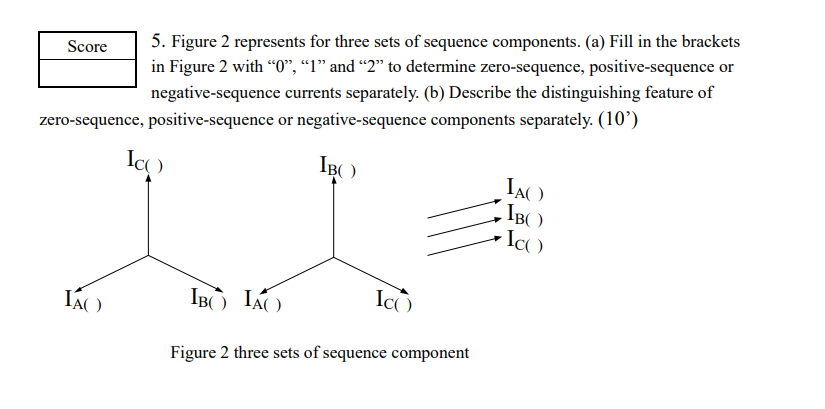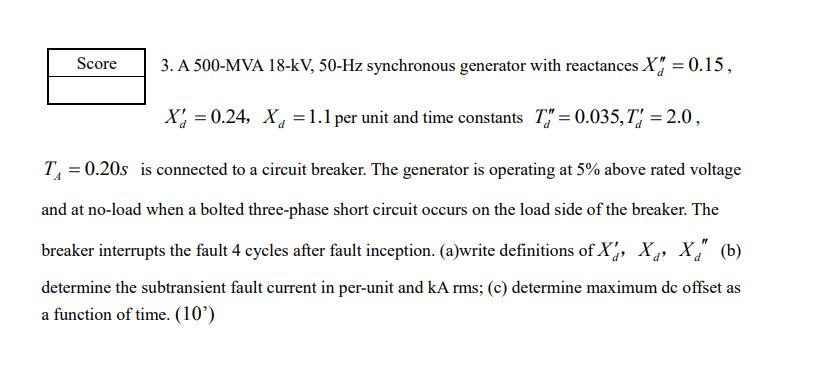Score 5. Figure 2 represents for three sets of sequence components. (a) Fill in the brackets in Figure 2 with "0", "1" and "2" to determine zero-sequence, positive-sequence or negative-sequence currents separately. (b) Describe the distinguishing feature of zero-sequence, positive-sequence or negative-sequence components separately. (10¹) IBO Ic() IAO ICO IBO IAO Figure 2 three sets of sequence component IÃO IBO Ico
Score 5. Figure 2 represents for three sets of sequence components. (a) Fill in the brackets in Figure 2 with "0", "1" and "2" to determine zero-sequence, positive-sequence or negative-sequence currents separately. (b) Describe the distinguishing feature of zero-sequence, positive-sequence or negative-sequence components separately. (10¹) IBO Ic() IAO ICO IBO IAO Figure 2 three sets of sequence component IÃO IBO Ico
Power System Analysis and Design (MindTap Course List)
6th Edition
ISBN:9781305632134
Author:J. Duncan Glover, Thomas Overbye, Mulukutla S. Sarma
Publisher:J. Duncan Glover, Thomas Overbye, Mulukutla S. Sarma
Chapter7: Symmetrical Faults
Section: Chapter Questions
Problem 7.6P
Related questions
Question
Subject:POWER SYSTEM ANALYSIS
AND DESIGN
I want to know many details of these 4 Questions Answer. And the teacher who will do these questions and answers for me must explain part by part. If you send me the answers after five hours, there is no problem, but the handwriting must be clear. please do all the question, i need all the question please . Thank you in advance,

Transcribed Image Text:Score
5. Figure 2 represents for three sets of sequence components. (a) Fill in the brackets
in Figure 2 with "0", “1” and “2” to determine zero-sequence, positive-sequence or
negative-sequence currents separately. (b) Describe the distinguishing feature of
zero-sequence, positive-sequence or negative-sequence components separately. (10')
IBO)
Ic()
IAO
IBO)
-ICO
ICO
IBO IAO
Figure 2 three sets of sequence component
IÃO

Transcribed Image Text:Score
3. A 500-MVA 18-kV, 50-Hz synchronous generator with reactances X = 0.15,
X = 0.24, X = 1.1 per unit and time constants T=0.035, T = 2.0,
T₁ = 0.20s is connected to a circuit breaker. The generator is operating at 5% above rated voltage
and at no-load when a bolted three-phase short circuit occurs on the load side of the breaker. The
breaker interrupts the fault 4 cycles after fault inception. (a)write definitions of X, X₁, X" (b)
determine the subtransient fault current in per-unit and kA rms; (c) determine maximum dc offset as
a function of time. (10')
Expert Solution
This question has been solved!
Explore an expertly crafted, step-by-step solution for a thorough understanding of key concepts.
Step by step
Solved in 4 steps with 3 images

Knowledge Booster
Learn more about
Need a deep-dive on the concept behind this application? Look no further. Learn more about this topic, electrical-engineering and related others by exploring similar questions and additional content below.Recommended textbooks for you

Power System Analysis and Design (MindTap Course …
Electrical Engineering
ISBN:
9781305632134
Author:
J. Duncan Glover, Thomas Overbye, Mulukutla S. Sarma
Publisher:
Cengage Learning

Power System Analysis and Design (MindTap Course …
Electrical Engineering
ISBN:
9781305632134
Author:
J. Duncan Glover, Thomas Overbye, Mulukutla S. Sarma
Publisher:
Cengage Learning